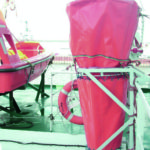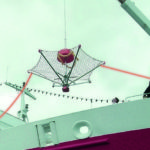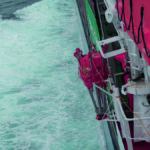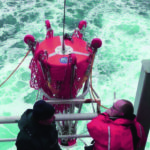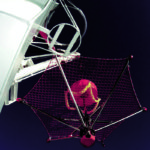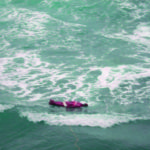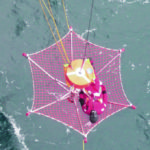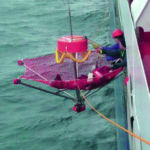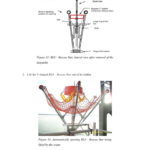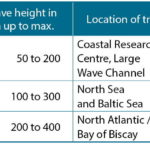Research report on main recovery-related problem areas in the rescue of persons in distress at sea and recovery-related requirements to be met by life-saving appliances
Prof. Michael Schwindt
Part 3
4 Findings
With the analysis of the main problem areas that can be[ds_preview] observed and are likely to be en-countered when rescuing persons in distress at sea, it was possible to gain evidence regarding general requirements which will inform the development of recovery methods and innovative life-saving appliances.
It was possible to show how, with the allocation of functions in a two recovery system com-ponent solution, the requirements described can be realized technically.
The results of the tests of the first recovery system component, the second recovery system component and the interaction between the two recovery system components in variable sea states are summarized in the following table.
5 Practical use
5.1 Information on practical use
In addition to the recovery-related main problem areas described above, the requirement identified in section 3.2 for »simple operation of the entire system for ships’ crews« is of great importance, because a rescue action in an emergency is always an exceptional situation that is not part of the everyday routine of a ship’s crew.
Operation requires only three steps:
1. Remove the tarpaulin
2. Lift the V-shaped RLS-Rescue Star out of its holder
The RLS-Rescue Star unfolds automatically and is fully operational.
3. Lower the opened RLS – Rescue Star into the water, controlled by two guide ropes.
To prevent pendular motion, the two guide ropes are operated from on deck.
5.1 Information on operating the RLS-Rescue Star recovery device
The possibility of making technical use of the aforementioned advantages of a two recovery system component solution for particularly user-friendly and easy operation is described in detail in the following for practical use on board:
If the submersible second recovery system component is designed such that it is collapsible like an umbrella, with the arms of the collapsible frame being pushed upwards towards the crane cable with the help of a sliding member on the centre tube for the stand-by position, this produces a V-shaped arrangement that takes up very little space on deck (see Figures 31 and 32).
The V-shaped arrangement has the additional advantage that it can accommodate, in its top quarter, the buoyant first recovery system component, which is designed as a ring-shaped disc, thereby preventing a dead centre when the second recovery system component is opened. For the stowage position, this results in a very simple and variable system comprising a small lower ring into which the collapsible frame of the second recovery system component, folded up like an umbrella, can be placed from above.
Protected against automatic unintentional opening, the arms of the second recovery system component (collapsible frame) are placed from above into a second, upper and larger ring which, together with the lower ring, exhibits a shape similar to an umbrella stand.
If the crane cable is permanently connected to the recovery device, the device is lifted vertically by the crane out of the ring holder for deployment. In the process, it opens automatically and stretches the net. If the crane operator lowers the appliance with its opened frame (second recovery system component) and the rescue disc (the buoyant, first recovery system component) into the water, the first recovery system component automatically floats up and down on the crane cable or crane cable forerunner and is fully operational for picking up persons adrift in the water.
In practical use, the ship’s crew should use the two guide ropes attached to the arms of the collapsible frame in order to prevent pendular motion on the ship’s side.
5.2 Information on navigating and manoeuvring the ship
When the system is in practical use, those responsible for navigating the ship must avoid and reduce the remaining headway of the ship in order to ensure that the second recovery system component is submerged below the trough of the waves. Here, they must take care that the ship no longer makes any headway through the water. Practical trials have shown that it is important that the captain allows the ship to drift towards the recovery position, making use of wind and waves. Homing in on the object should be avoided wherever possible.
It is not absolutely imperative that a specific condition in relation to the waves (lee) be maintained for technical reasons related to the device, but it is recommended simply for reasons of drift and to ensure maximum protection for the person in the water. Drills should thus be regularly conducted, although there should be much greater focus on the captain and the success of the manoeuvre he is to perform than on the simple and safe launching of the RLS-Rescue Star by the crew on deck.
With this technical design of the RLS-Rescue Star the crew require only one briefing to become familiar with the entire system and understand how it works. With this solution, none of the ship’s crew has to leave the safety of the ship. There is no danger of the crew putting themselves at risk, as when launching a rescue boat. In addition, dry runs can be carried out to practise launching the recovery system when the ship is in dock and at sea in order to sufficiently familiarise the crew with its operation.
Bibliography
Article in …
• Brons, Rob K. and Brewster, B. Chris (2006), »Task Force on Rescue — Rescue Techniques«, in Bierens, Joost J. L. M. (ed.), Handbook on Drowning. Prevention, Rescue, Treatment,. Berlin, Heidelberg, Springer-Verlag Berlin Heidelberg, pp. 193–308.
Grey literature / report
• Federal Bureau of Maritime Casualty Investigation (1 April 2006), Sehr schwerer Seeunfall. Überbordgehen des Skippers mit Todesfolge am 1. Mai 2005 auf der SY INA 2 N-lich von Wustrow, published by the Federal Bureau of Maritime Casualty Investigation (BSU), Hamburg. (Investigation Report 149/05). Available online at http://www.rolfdreyer.de/Downloads/Skipper_ueber_Bord_2.pdf, last checked on 23 April 2010.
• Schwindt, Michael (10 February 2009), research report by Prof. Michael Schwindt dated 10 February 2009.
Internet document
• Baumeier, Wolfgang (2006), Das SARRRAH-Projekt. Entwicklungsprojekt Rescue Lifting System (RLS), Department of Anesthesiology, UK S-H, Campus Lübeck. Available online at http://www.sarrrah.de/cms/index.php?option=com_content&task=view&id=7/, last checked on 23 April 2010.
Monographs
• Golden, Frank and Tipton, Michael (2002), Essentials of sea survival, Champaign, IL, Human Kinetics Publishers.
• International Maritime Organization (IMO), A pocket guide to cold water survival, 3rd ed. (2006), London (IMO publication).
• International Maritime Organization (IMO), A pocket guide to recovery techniques (2007), London (IMO publication).
• Oehmichen, Manfred (2004), Hypothermia. Clinical, Pathomorphological and Forensic Features, 31st ed., Schmidt-Römhild.
Patents
• Schwindt, Michael, Auxiliary device to be used for bringing aboard a person towed to the exterior of a ship’s side by a recovery device. Application number: DE10313423B4.
• Schwindt, Michael, Carbine hook (special carbine hook for the recovery of persons in distress out of the water with a self-locking dual chamber system). Application number: DE 10239755B4.
• Schwindt, Michael, Recovery device for a person adrift in the water. Application number: DE10313424B4
• Schwindt, Michael, Recovery device for the recovery of a person from the water. Application number: DE19745408B63C9/28.
• Schwindt, Michael, Recovery lifting device for a yacht for lifting a person out of the water. Application number: DE4326657.6-22C2.
• Schwindt, Michael, Methods and equipment for the recovery of persons in distress at sea. Application number: 50108014.7; EP 1303438B1.
• Schwindt, Michael, Methods and equipment for the recovery of casualties. Application number: EP 1305084B1
• Schwindt, Michael, Methods and equipment for the recovery of casualties. Application number: DE10037868B4
• Schwindt, Michael, Methods for the deployment of a recovery device from a ship for a person adrift in the water and recovery device for a person adrift in the water. Application number: DE10313425B4
• Schwindt, Michael (2005), Methods for the deployment of a recovery device from a ship and from a helicopter for one or more persons adrift in the water and recovery device for one or more persons adrift in the water. Application number: DE102005059430B3.
• Schwindt, Michael (2006), Recovery system for the recovery of one or more persons adrift in the water from a ship. Application number: DE102006044262B3.
• Schwindt, Michael (2008), Anchor for the recovery of one or more persons adrift in the water from a ship. Application number: DE102008051049B4.
Edited volume
• Bierens, Joost J. L. M. (ed.) (2006), Handbook on Drowning. Prevention, Rescue, Treatment, Berlin, Heidelberg, Springer-Verlag Berlin Heidelberg.
Audiovisual documents
• Seeberufsgenossenschaft, RLS – Rescue Lifting System. RLS – double strop recovery system for the recovery of persons at sea (in English). Other participants: Schwindt, Michael (ed.), Seeberufsgenossenschaft.
• Seeberufsgenossenschaft (2002), Kreislaufstillstand bei Unterkühlung. Wiederbelebung auf See. Other participants: German Maritime Search and Rescue Service (ed.), Baumeier, Wolfgang (dir.), Seeberufsgenossenschaft.
• Seeberufsgenossenschaft (2007), Forschung und Entwicklung neuer Systeme. Rettungsgeräte zur Rettung von Personen aus dem Wasser. Other participants: Baumeier, Wolfgang; Schwindt, Michael; Lange, Peer; Department of Anesthesiology, UK S-H, Campus Lübeck; German Federal Police; Waterways and Shipping Directorate Northwest; Hannover professional fire brigade (ed.); Börner, Christian (dir.), Seeberufsgenossenschaft.
• Seeberufsgenossenschaft (2009), Hypothermie. Medizinische Erstmaßnahmen bei Unterkühlung. Other participants: Department of Anesthesiology, UK S-H, Campus Lübeck; German Federal Police (ed.); Baumeier, Wolfgang (dir.), Seeberufsgenossenschaft.
• Seeberufsgenossenschaft (2009), Person über Bord! Rettung auf hoher See. Rettungsgeräte zur Rettung von Personen aus dem Wasser. Other participants: Lange, Peer; Schwindt, Michael; NSB shipping company; Nautilus Marine; Baumeier, Wolfgang (ed.); Börner Christian (dir.), Seeberufsgenossenschaft.
Articles in journals
• Baumeier, Wolfgang (2008), ‘Severe accidental hypothermia. Rescue and treatment procedures at sea’, in Notfall & Rettungsmedizin, Volume 11, no 7, pp. 463-468. Available online at doi:10.1007/s10049-007-0988-2, last checked on 23 April 2010.
• Golden, Frank, Hervey, G. R. and Tipton, Michael (1991), ‘Circum-rescue collapse: collapse, sometimes fatal, associated with rescue of immersion victims’, in Journal of the Royal Naval Medical Service, Volume 77, no 3, pp. 139-149.
• Lange, Peer (2007), ‘Der lange Weg an Bord. Neue Rettungsmittel – vom Prototyp zum internationalen Standard’ in See Sozial, no 1, pp. 8–9. Available online at http://www.bg-verkehr.de/medien/see-und-sicherheit-archiv/seesozial_2007_01.pdf, last checked on 23 April 2010.
• Lange, Peer (2007), ‘Rettung aus der See – die ungelöste Herausforderung. Teil 1’, in HANSA International Maritime Journal, no 9, p. 74.
• Lange, Peer (2007), ‘Rettung aus der See – die ungelöste Herausforderung. Teil 2’, in HANSA International Maritime Journal, no 10, p. 130.
• Lange, Peer (2007), ‘Rettung aus der See – die ungelöste Herausforderung. Teil 3’, in HANSA International Maritime Journal, no 11, p. 87.
• Lange, Peer (2007), ‘Rettung aus der See – die ungelöste Herausforderung. Teil 4’, in HANSA International Maritime Journal, no 12, p. 16.
• Rollnik, J. D., Witt, K., Hänert, W., Rix, W. and Schwindt, Michael (2001), ‘Rescue lifting system (RLS) might help to prevent death after rescue from immersion in cold water’, in International journal of sports medicine, Volume 22, no 1, pp. 17–20. Available online at doi:10.1055/s-2001-11361.
• Urbach, Wolfgang (1994), ‘Unterkühlung, ein ernstes Thema’, in YACHT, November 1994 issue, pp. 49–50.
• Wiebe, Bettina and Lange, Peer (2009), ‘Rettung aus der See. RESCUE-STAR. SAR Szenario – LT CORTESIA über die Schulter geschaut…’, in NSBmagazine, no 10, pp. 28–30. Available online at http://www.reederei-nsb.de/site_de/index.php?node_id=2338&node_id_back=2347&newsid=74, last checked on 23 April 2010.
Appendix
Article and figures of the operational demonstration on MV LT Cortesia in the North Atlantic by courtesy of NSBmagazine and BG Transport:
Wiebe, Bettina and Lange, Peer (2009), ‘Rescue at Sea. The Unsolved Challenge. SAR scenario – looking over the shoulder of LT CORTESIA …’, in NSBmagazine, no 10, pp. 28–30.
Rescue at Sea. The Unsolved Challenge
After the article on the rescue on CMA CGM BAUDELAIRE in No. 6 of our NSBmagazine describing how lives could be rescued with a net, I thought: »OK, great, let’s now retrofit all ships with these rescue nets.« But that was jumping to conclusions, as at that time I still didn’t know anything about the so-called »rescue collapse«.
Did you know that shipwrecked persons picked up by helicopter are rescued alive but then frequently die in the helicopter? A person rescued vertically basically risks a »rescue collapse«, which can lead initially to ventricular fibrillation and in the end to death after rescue. The danger with the changed circulation and metabolism situation is greatest with undercooling. There is the same risk when a person actively climbs on board as with a vertical helicopter rescue.
Emergency doctors have thus been calling for the horizontal rescue of a person from the water since the 1970s. In September 2006, the See-Berufsgenossenschaft Hamburg (Seamen’s Accident Prevention and Insurance Association) set up a working group as a platform for developers of such systems.
Previously there was the announced accident on board HANSA BERGEN in June 2004, during which the second officer, Kerstin Bruns, was washed over board during a gangway control. After drifting for 20 hours in the Indian Ocean 200 nm off Mauritius without personal rescue equipment, Kerstin Bruns managed on her own – as if by a miracle – to climb on board. She had initially failed to get on board via a pilot’s ladder because of injuries and waves with a height of six metres or more.
The See-BG is calling for a regulation for obliging all ships worldwide to carry this rescue equipment at the IMO (International Maritime Organization). With this in mind, the prototype of the so-called RESCUE-STAR was tested on board our LT CORTESIA, and a film was made for screening for demonstration purposes at the IMO and as a training film at navigation schools.
Please read the report by Captain Peer Lange on the test on LT CORTESIA.
Bettina Wiebe
SAR scenario – looking over the shoulder of LT CORTESIA …
A heavy weather test of the new recovery system RLS RESCUE-STAR was planned on the container-ship LT CORTESIA (ex »Conti Cortesia«) for the Gulf of Biscay on a voyage from Hamburg to Singapore, departing Hamburg on January 23rd 2009. In addition to the crew, the developer of the RESCUE-STAR, Prof. Michael Schwindt, the film producer, Christian Boerner and me as a representative of the See-BG, Flag State Administration of Germany, were on board. The See-BG is the coordinator and had supported the project financially. With the live tests and the new film, we believe the recovery system project can be brought forward on the international working level of the IMO and be made more comprehensible for all parties concerned.
After leaving the European ports of Rotterdam and Thamesport on January 28th 2009, the shooting of the documentation began with nine cameras in the Gulf of Biscay. A dummy was put over board for recovering and hoisting back on deck simulating a »person over board« situation. The operation of a rescue boat was not possible due to bad weather conditions. After the stopping manoeuvre, the RESCUE-STAR was let down by the Suez crane into the water and lowered below the water surface and waves as intended. The dummy was pulled to the orange-coloured rescue disc, and when it was in the correct and safe position above the RESCUE-STAR, which was below the waterline, the bosun hoisted the RESCUE-STAR with the Suez crane on command. The dummy was secured safely close to the centre of the net of the RESCUE-STAR. The rescue operation for taking the dummy on board was performed in less than three minutes after the stopping manoeuvre.
If the person in the water is unable to reach the rescue disc by swimming, alternatively a line connection with a pneumatic line throwing device can be used. This is an acceptable result especially with weather conditions such as wind up to 7 Beaufort and wave heights of four meter for a rolling ship with 20° on each side.
Three criteria for achieving a satisfactory result are:
1. A suitable recovery system has to be available on board. The RLS RESCUE-STAR fulfils the requirements nearly optimally; persons in the water can be taken on board without changing their position in a horizontal and gentle way in accordance with medical aspects (compared with taking over into a rescue boat).
2. The vessel is not supposed to make any speed through the water if the RESCUE-STAR is in the water.
3. The crew has to be familiarised with the equipment and its functions. For the operation of the RESCUE-STAR no more persons are needed than for the operation of the regular rescue boat.
A real rescue operation can be performed even on large cargo ships with a ship side of 17-20 meters height in rough weather conditions, as shown by the demonstration on LT »Cortesia«. According to the IMO, recovery systems will be mandatory on cargo and passenger ships from 2012 at the earliest. It will be a real hope for the rescue of helpless people in the water.
The chain of rescue is as strong as its weakest link. Recovering people from the sea is the weakest link in the chain of rescue. This new technology closes the safety gap.
It’s another big step forward for merchant shipping.
• Advantages:
– No risk for own crew because no rescue boat has to be waterborne.
– The RESCUE-STAR works independently of wave heights and wave directions.
– The vessel does not need to take any special rescue position and can move into the most appropriate and safe position. This is important for large container-ships, which have to take special care of their container cargo. It is recommended to drift with the vessel directly to the persons in the water so that the midship section meets the survivors in the water. From the midship position, the persons can be pulled safely to the rescue disc of the RESCUE-STAR.
• Disadvantages:
A new item of equipment; for installations on existing ships a suitable position on board has to be found offering a position from where the devices can be operated depending on the vessel’s type and size. Training and familiarisation with the new equipment has to be carried out at regular intervals.
Captain Peer Lange, See-BG







